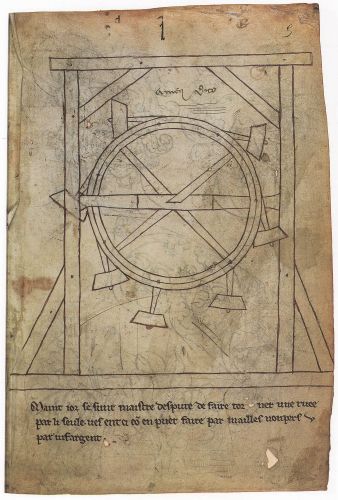Error
Mechanical overbalanced wheel
Although it is difficult to imagine the content and tone of the scientific-engineering debate on the subject of perpetual motion in 13th century Europe, it is important to note that the only manuscript by a medieval architect-engineer that has come down to us, the socalled Notebook of Villard de Honnecourt, contains a very rudimentary drawing of a wheel with articulated arms, which can be conceptually traced back to its antecedent in the Arab tradition. It is believed that Villard’s notebook, produced by various different writers, was compiled mainly between 1225 and 1235, i.e. 30 years earlier than the manuscript copied by Rubi Zag: this would allow us to assume that the debate on perpetual motion was actually introduced into Europe during the first half of the century.16 Below the drawing of his articulated arm wheel with oscillating masses, Villard notes that “for a long time the masters (maistre) have been discussing how to make the wheel turn on its own. Here’s how the thing can be done by a fixed number of mallets or with quicksilver” (fig. 2).17 The fact that the drawing simply shows the option with oscillating arms, without referring to the possibility of replacing the “mallets” with mercury displacement cylinders, could indicate that Villard had not seen a drawing of this wheel and that he was relying on indirect knowledge in order to reproduce the simplest version of the device. Interesting, too, is the reference to the “masters” who discuss how they could make the wheel turn on its own: it helps us imagine a debate among technicians which had gone unreported in both the written and iconographic sources until this period, an indication perhaps of the fact that the protagonists of this cultural context were not familiar with writing and relied on the oral tradition to pass on their knowledge and ideas.


